Route: French Riviera in 2 Weeks
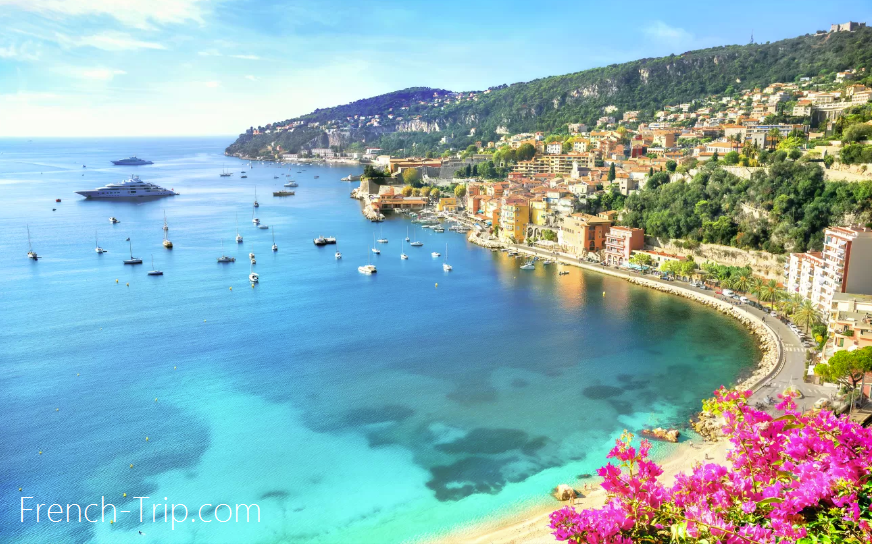
If you have two weeks to explore the French Riviera, there’s no need to rush as you would with just one week in Provence. With more time on your hands, you can leisurely traverse the Côte d’Azur, starting in the west with Saint-Tropez and making your way to Menton in the east, bordering Italy. The major highlights of the French Riviera include not only Saint-Tropez but also the glamorous resort town of Cannes, the vibrant city of Nice (the Riviera’s capital), and even the elegant principality of Monaco. You can relax on the world’s finest beaches or allocate time to visit some of the world’s best contemporary art galleries and museums, of which there are plenty on the French Riviera.
Route: French Riviera in 2 Weeks
To explore the cities along the “French Riviera in 2 weeks” route more efficiently, you can also take advantage of city walking tours tailored to each respective city.
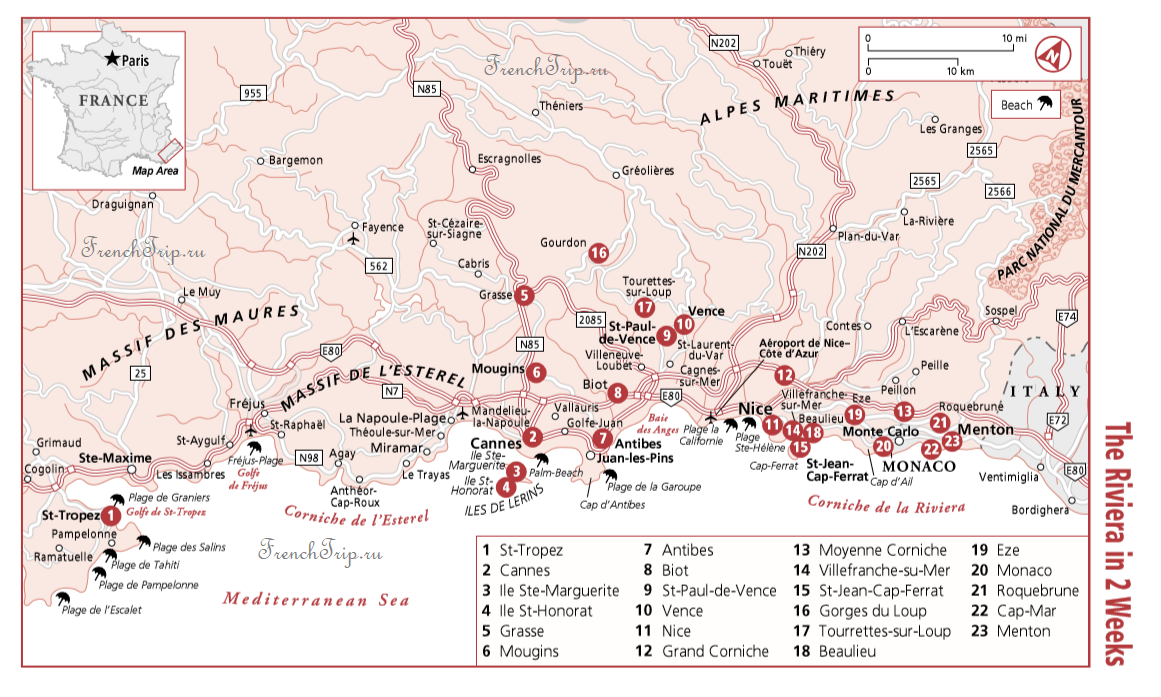
Days 1 and 2: Saint-Tropez: Gateway to the Riviera
Following in the footsteps of the blonde goddess, actress Brigitte Bardot, you can reach the nearest train station in St-Raphaël and then complete the remaining part of your journey to Saint-Tropez by boat or bus.
Saint-Tropez has beautiful beaches, the best of which include the amusingly named Plage de la Bouillabaisse or Plage de Graniers. After a day on the beach, stop by Café de Paris for a glass of wine before dinner and watch the locals: it’s home to the Riviera’s most colorful characters on the Riviera. Enjoy a leisurely and extended dinner and take a stroll along the waterfront at night, admiring the fleet of yachts from around the world.

On the second day, before heading to the beach again – perhaps a different one this time – visit the Museo Annonciade, the first of the modern art collections that opened on the Riviera in 1955. You can browse the boutiques before heading down to Plage de Tahiti, a favorite among exhibitionists. If you dare, you can also relax without clothes. On your last night in Saint-Tropez, take a stroll to the harbor in the city center.
- Tourist route in Saint-Tropez
- Sights of Saint-Tropez
- Beaches of Saint-Tropez
- Top 10 attractions in Saint-Tropez
Days 3 and 4: Cannes
On Day 3, drive east 86 km along the coast to the Riviera’s most legendary resort, chic, sophisticated Cannes, home of the famous International Film Festival. After checking into your hotel, take a stroll along the Croisette to see why Cannes is so beloved. Find a waterfront restaurant for lunch and head to the beach in the afternoon. The best beach in Cannes is Plage de la Croisette, stretching between Vieux Port and Port Canto.
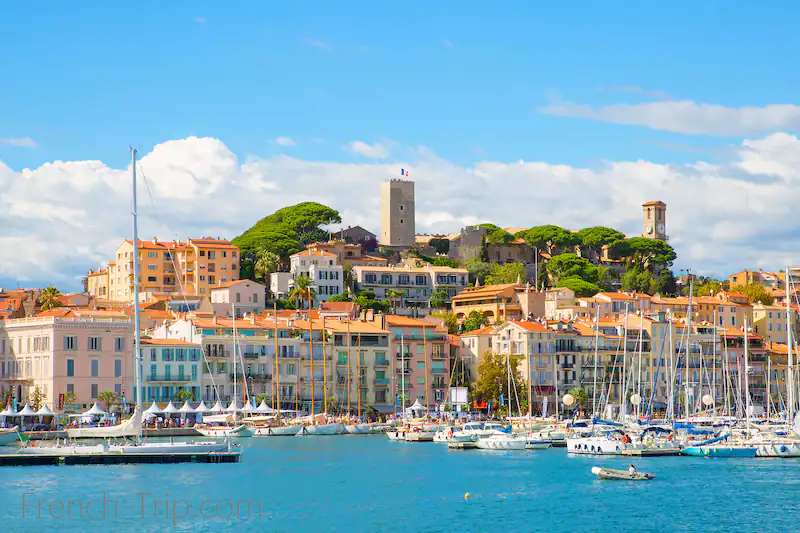
On the morning of the 4th day, take a ferry to Ile Ste-Marguerite, the most famous of the Lérins islands, where the mysterious “Man in the Iron Mask” was held captive. You can spend the whole morning exploring the island and have lunch here. You can also visit the second major island, Ile St-Honorat with its Abbey of Saint-Honorat, or you can return to Cannes, again spending the afternoon on the beach. If you’re a gambler, you can visit one of the resort’s sparkling casinos.
Day 5: Grasse, Mougins and Antibes
On the morning of day 5, leaving Cannes in your rental car, drive north 14 km on the N85 to Grasse, which can be reached in just 20 minutes. This is the perfume capital of France and you can visit its factories, called parfumeriein. The best are Fragonard and Molinard. Instead of having lunch in Grasse, head back 8 km along the road to Cannes, but stop in the village of Mougins, which was Picasso’s favorite spot. It’s worth visiting for lunch, as Mougins has some of the best restaurants on the Riviera.
Returning to the coast, follow the route to Antibes, where you can spend the night. Picasso also lived in Antibes, as evidenced by the many paintings he left to the Musée Picasso, one of the greatest collections of his work. After visiting the museum, take a trip through the chic Cap d’Antibes to see how the very rich live, ever since F. Scott Fitzgerald portrayed the resort in his novel Tender is the Night. Stay overnight in Antibes and stroll through its port at night, dining at a traditional seafood bistro.
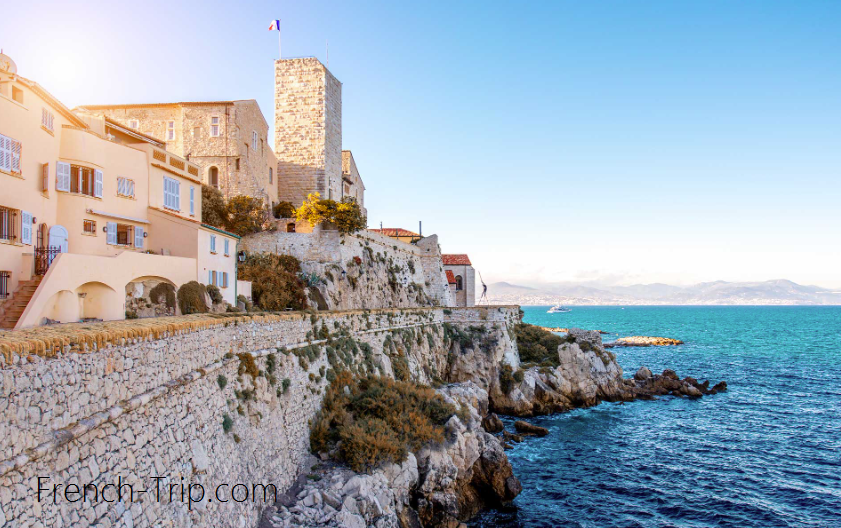
- Guide to Grasse
- Guide to Antibes
- Artists in Provence
Day 6: Biot and Saint-Paul-Vence
Leaving Antibes in the morning, drive north 12 km to the town of Biot, famous for its beautiful pottery. Here you can also visit the Fernand Léger National Museum, which houses the largest collection of Léger’s works in the world.
After lunch in the city, head northeast 10 km to the most famous mountain town along the Riviera: Saint-Paul-de-Vence. After checking into your hotel, visit the Fondation Maeght, the most famous and best contemporary art gallery on the Riviera, and in fact one of the best such museums in Europe. Spend the evening strolling the city’s cobbled streets.
- Guide to Saint-Paul-de-Vence
- Tourist route around Saint-Paul-de-Vence
Days 7 and 8: Vence and Nice
On the morning of day 7, drive 6 km to the nearby mountain town of Vence to see the Chapelle du Rosaire, a chapel that Henri Matisse designed and decorated in 1947 and 1951. He considered it as his masterpiece.
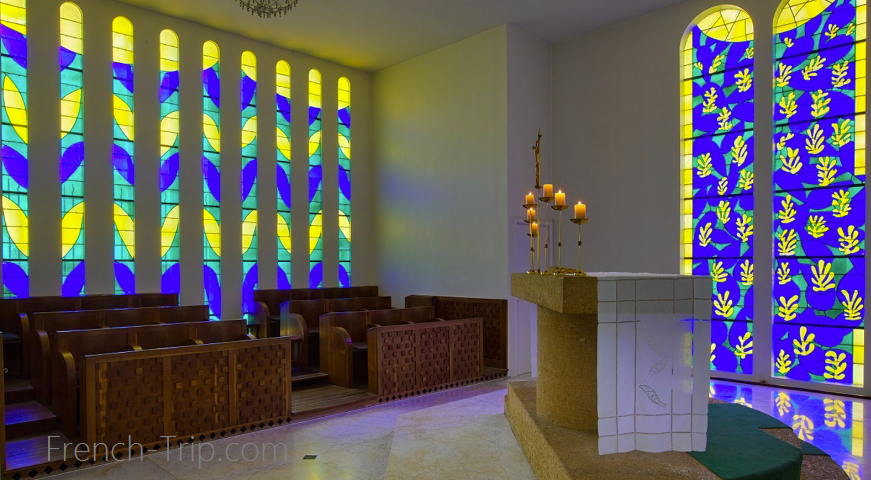
After about one hour visit, travel 40 km southeast to Nice, where you will spend 3 nights, some of which will be dedicated to excursions.
After checking into your hotel, take a stroll through Vieille Ville, Nice’s Old Town, starting at the foot of the “Rock“. Enjoy the socca snack, a round pancake made with chickpea flour sold by hot street vendors. Then head to the promenade des Anglais, a wide boulevard along the waterfront. You can spend at least an hour wandering, perhaps stopping at one of the grand cafes along the waterfront for a traditional Niçoise salad for lunch. During the day, head to one of Nice’s beaches. Returning to the Old Town of Nice in the evening, consider visiting a typical bistro for dinner.
During the day, you can explore some of Nice’s major attractions, including two of the most important museums: the Museum of Modern and Contemporary Art (Musée d’Art Moderne et d’Art Contemporain), one of the finest contemporary art museums in the region, and the Museum of Fine Arts (Musée des Beaux-Arts), dedicated to the masters of the Second Empire and belle époque. In the remaining part of the day, head to the nearby village of Cimiez and try to visit the Matisse Museum to see the works of the master himself. Return to Nice for the night, where you can attend the opera, visit a casino, or enjoy live music at one of the many bars in Vieux Ville (Old Town).
- Nice travel guide
- Nice attractions
- Top 10 attractions in Nice
- Tourist route around Nice
- Guide to Vence
Day 9: Grande Corniche & Moyenne Corniche
On Day 9, still staying at your hotel in Nice, head to the most impressive road in the south of France – the Grande Corniche, built by Napoleon in 1806. The 32 km (20-mile) drive takes about 3 hours, although many motorists stop for a series of stunning views, stretching the trip to at least 5 hours.

From Nice, head east along avenue des Diables-Bleus. From the viewpoints along this route you can look down 450m onto the magnificent landscapes of the French Riviera, with panoramic views all the way to Monaco. The main attraction along the road is the panoramic view of Vistaëro – it’s marked – which is 300m above the sea. Another grand view can be seen at Eze Belvedere. The highest point along the Grande Corniche is Trophée des Alps, a 450 m high mountain peak.
You can have lunch in Menton before returning to Nice along the 31km Moyenne Corniche, or Middle Cornice. This highway, built “between the wars”, also runs from Nice to Menton and passes through tunnels cut through the mountains. Many places along this great highway offer panoramic views, including some of Monaco. Return to Nice for the night.
Day 10: Villefranche-sur-Mer and Saint-Jean-Cap-Ferrat
To save money with affordable hotels, you can still stay overnight in Nice, where you can also see attractions along the French Riviera such as Villefranche and Saint-Jean-Cap-Ferrat on Day 10. Access to Villefranche is via a 6km road east of Nice. You can stroll along its vaulted Rue Obscure and visit the 14th-century Romanesque Chapel Saint-Pierre with frescoes painted by Jean Cocteau.
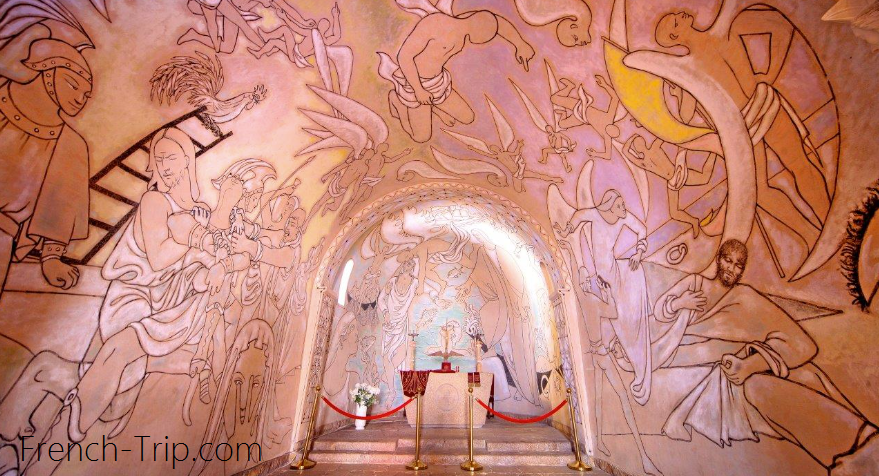
In the late morning, after an hour or two in Villefranche, you can drive to chic Saint-Jean-Cap-Ferrat, a 15-kilometre headland that lies 10 kilometers east of Nice. Here you will find one of the most legendary villas on the Cote d’Azur, which today is home to the Ile-de-France art museum – Rothschild’s Villa Etrussi. Allow 2 hours for your visit and spend time on the beach, such as Plage de Paloma, before returning to Nice.
Day 11: Explore the Gorges du Loup
Again staying overnight in Nice, head to the Gorges du Loup on Day 11 to see some of the most dramatic scenery in the mountains above the Cote d’Azur. You can drive 13 km along the road with impressive scenery, past waterfalls, rocky spurs and castles.
For lunch, head to Tourrettes-sur-Loup, which is located 29 km west of Nice. You can spend a day here strolling its ancient streets and exploring the artisan workshops, of which there are more than any other town of its size in Provence. The best of them are presented on Grand’Rue.
After lunch, return to Nice, hoping to reach the beach in time. Another night in Nice before heading east the next day.
Days 12 and 13: Beaulieu, Eze and Monaco
Leave Nice on day 12, heading east along the Lower Corniche or Corniche Inférieure. First stop: the chic resort of Beaulieu, just 10 km east of Nice. The city opens onto the tranquil Bay of Fourmy and you can stroll along its Boulevard Alsace-Lorraine, surrounded by beautiful gardens. The waterfront is another idyllic place for a walk. The highlight of your visit will be Villa Kerylos, a replica of an ancient Greek residence full of works of art.
After visiting Beaulieu, continue along the coast of the French Riviera to the village of Eze, located 11 km northeast of Nice. Here you can have lunch and explore the medieval core of this old town, which is filled with shops, craft shops and art galleries. Visit the Jardin d’Eze with cacti and panoramic views of the eastern Riviera.
After this, continue east to the Principality of Monaco, stopping there for 2 nights. After checking into your hotel, head to Le Café de Paris, the heart of local life. You can also have lunch here.
On day 13, explore the principality, perhaps witness the changing of the guard and visit Les Grands du Palais, where Prince Albert now rules the Monegasques after the death of Prince Rainier in 2005. Allow about 45 minutes to explore the Jardin Exotique, filled with exotic plants. Another most visited attraction is the Oceanographic Museum (Musée de l’Oceanographie). If you have time, visit Prince Rainier III’s Collection des Voitures Anciennes. Spend another night in the Principality, strolling along the promenade before dinner.
Day 14: Roquebrune, Cap Martin and Menton
On Day 14, your last day on the Riviera, continue along the Lower Corniche until you reach two attractions: Roquebrune and Cap Martin.
Roquebrune is a mountain village that you can see in an hour and a half. Stroll through its covered streets, which are filled with craft shops, art galleries and gift shops. The most memorable street is rue Moncollet, built in the 10th century.
Head further to the village of Cap-Martin, which is 2 km west of Roquebrune. After lunch you can take one of the Riviera‘s great walks, the 3-hour hike along the Sentier Touristique coastal path. Afterwards, head to Menton for the night, located 8 km east of Monaco. After checking into your hotel, wander around its old fishing town, choosing a local restaurant for dinner. The next morning we return to Nice, the transport hub of the Riviera.
Archives
Calendar
| M | T | W | T | F | S | S |
|---|---|---|---|---|---|---|
| 1 | 2 | 3 | 4 | 5 | 6 | 7 |
| 8 | 9 | 10 | 11 | 12 | 13 | 14 |
| 15 | 16 | 17 | 18 | 19 | 20 | 21 |
| 22 | 23 | 24 | 25 | 26 | 27 | 28 |
| 29 | 30 | 31 | ||||